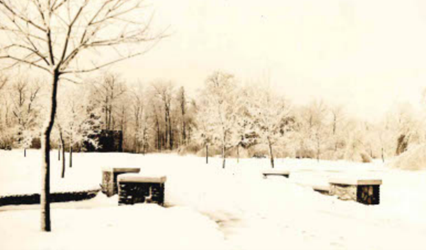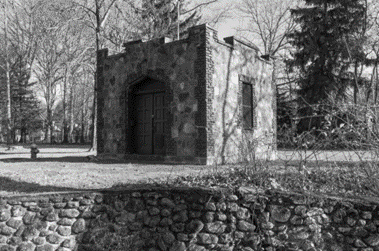History of the Cedar Hill Well Field - Miniature Castles
The Ridgewood Water Department originated in 1900 as a private utility known as the Bergen Aqueduct Company, sinking deep artesian wells to supply water to Ridgewood Village. Over the years, the company expanded to provide water to Midland Park, Glen Rock, Wyckoff and part of Ho-Ho-Kus. Ridgewood Village purchased the entire water system in 1921. The water department was critical to the health and economic vitality of the communities.

As population grew, the Ridgewood Water Department struggled to meet the needs of its consumers. In response, the department purchased the 10-acre Cedar Hill property in 1933. At the time, Cedar Hill was the location of a tumbledown colonial farmhouse, the Daniel Rutan House, which was razed around the same time. By 1938, the department had sunk six wells, each capped by a Gothic Revival-style well house. The department landscaped Cedar Hill and created a park-like setting with stone gates, flower planting beds, a small bridge and a manmade creek winding through the property.

The Ridgewood Water Department took, and still takes, considerable pride in the quality of its facilities. From the 1920s to the 1940s, it adorned its buildings in the Gothic Revival-style, with decorative masonry and point-arch doors reminiscent of medieval castles. The extra cost was considered well worth the investment. The department boasted that its “beautiful parks” received “commendable praise from people far and wide.”
Historical and Archaeological Documentation of the Cedar Hill Well Field
In 2024, the Village of Ridgewood entered into an agreement with the U.S. Environmental Protection Agency (EPA) and the New Jersey Historic Preservation Office (NJHPO) to historically document the Cedar Hill Well Field prior to building a new facility to remove per- and polyfluoroalkyl substances (PFAS) from the water and satisfy requirements of the Drinking Water State Revolving Fund (SRF) program and the Safe Drinking Water Act (SDWA). This documentation, along with an archaeological investigation of the Daniel Rutan House Site, as well as public educational outreach, were a requirement of complying with Section 106 of the National Historic Preservation Act and accessing federal-state financing administered by the Municipal Finance and Construction Element (MF&CE) of the Division of Water Quality, New Jersey Department of Environmental Protection.
PFAS are long-lasting manmade chemicals, which break down very slowly over time. They are found throughout the environment due to their widespread use in thousands of consumer, commercial and industrial products. The impacts of PFAS are not fully understood yet but they have been linked to harmful health effects in humans and animals. Ridgewood Water is proactively installing a treatment facility to remove PFAS from water pumped from the Cedar Hill wells.

Professional architectural historians documented the Cedar Hill Well Field’s architecture and engineering to the standards of the Historic American Buildings Survey (HABS). The goal was to create a permanent archival record of the site to be placed on file at local and state repositories for current and future generations. The documentation package consists of high-quality digital and black-and-white print photography and a historic narrative written using factual data and first-hand sources to the greatest extent possible. To view a PDF of the entire HABS documentation package: Cedar Hill Well Field HABS
Ridgewood Water sponsored archaeological investigations of the Daniel Rutan House Site from 2023 to 2025, in order to recover archaeological data that would otherwise have been lost due to the construction of the new PFAS facility. These investigations progressed to reveal a fascinating site associated with the descendants of French Huguenot immigrants who settled in Wyckoff Township in the mid-1700s. The dig uncovered the house’s basement and a wide range of artifacts, offering insights into the everyday lives of our town’s early settlers. You can read the archaeologists’ posts, view photographs of the dig and artifacts, and follow the process of discovery here: Cedar Hill Blog Post Introduction
Useful Links:
To learn more about the Division of Water Quality and its programs: https://dep.nj.gov/dwq/about-dwq/
To learn more about Section 106 of the National Historic Preservation Act and other historic preservation laws: https://dep.nj.gov/hpo/tools/laws/
To learn more about PFAS: https://www.epa.gov/pfas/pfas-explained
